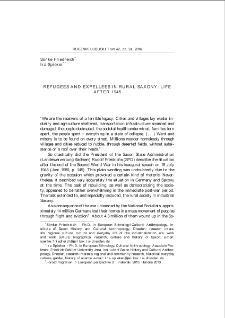Digital Library of Zielona Góra contains 65 391 digital objects
Object
Title: Refugees and expellees in rural Saxony: life after 1945 = Uchodźcy i wypędzeni na terenach wiejskich Saksonii po roku 1945
Contributor:
Bazuń, Dorota - red. ; Kwiatkowski, Mariusz - red.
Group publication title:
Abstract_pl:
Po rozpętanej przez Niemcy II wojnie światowej, miliony ludzi zostały zmuszone do przemieszczenia się, ludność niemiecka na obszary, dwóch państw niemieckich, które powstały po upadku Rzeszy Niemieckiej. Przyjęcie, integracja i ulokowanie uchodźców i wysiedleńców było dla społeczeństwa i przywódców politycznych NRD ogromnym wyzwaniem. ; W artykule przedstawiono procesy towarzyszące przybyciu uchodźców, które przybierały kształt różnorodnych konfliktów, nie tylko tych, do których dochodziło na poziomie politycznym, ale także takich, które zaznaczały się w zwykłym codziennym funkcjonowaniu. Jak pokazują oficjalne materiały pochodzące sprzed 1952 - a także potwierdzają to zeznania naocznych świadków - konflikty te dotyczyły w szczególności: dostępu do ograniczonych zasobów (nadających się do zamieszkania lokali, mebli, materiałów do pracy, etc.), prób powrotu do własnego terytorium, interwencji państwa (reformy rolnej, kolektywizacji). ; Te procesy były istotnymi czynnikami towarzyszącymi transformacji społeczności wiejskich. Sytuacji nie ułatwiało także to, że kwestia "przesiedleńców" stała się oficjalnym tabu w NRD, sprawiło to, że początek nowego życia pod auspicjami socjalistycznego kraju, a także społeczne relacje z sąsiednimi państwami czyli Polską i Czechosłowacją stały się nawet trudniejsze. ; Artykuł zawiera informacje pochodzące z projektu badawczego "Obcy - Ojczyzna - Saksonia. Wypędzeni jak nowi rolnicy. Działania integracyjne państwa i indywidualne strategie adaptacyjne". ("Fremde - Heimat - Sachsen. Vertriebene als Neubauern. Staatliche Integrationsmaßnahmen und individuelle Adaptionsstrategien"). ; Projekt był realizowany przez Instytut Saksońskiej Historii i Antropologii Kulturowej (Institut für Geschichte und Sächsische Volkskunde). W ramach tego projektu poddano analizie zbiory kilku archiwów państwowych oraz lokalnych. Ponadto zrealizowano i przeanalizowano sześćdziesiąt wywiadów ze świadkami tamtych czasów.
Abstract:
As a consequence of the Second World War unleashed by Germany, millions of people were forced to stream into the areas that subsequently became the two successor states of the German Reich. The acceptance and integration of the refugees and displaced persons presented the society and the political leadership of the GDR (German Democratic Republic) with an enormous challenge. ; This article will analyze the contradictory processes of the refugees` arrival that was marked by diverse conflicts, not only at the political level, but also in everyday practice. As the official files of the years up to 1952 show - and the testimony of eyewitnesses` accounts confirm - it was, in particular, the conflicts over such issues as scarce resources (livable housing, furniture, work materials, etc.), attempts to return to the home territories, as well as the state`s intervention (land reform, collectivization) that were the decisive factors in the transformation of rural society. ; Furthermore, the theme of the"?resettlers" was made officially taboo in the GDR which only rendered the new start under socialist auspices, as well as the public dealings with the neighboring states of Poland and Czechoslovakia, even more difficult. ; This article comes out of the research project "Strangers - Homeland - Saxony. Expellees as New Farmers. State Integration Measures and Individual Adaption Strategies" ("Fremde - Heimat - Sachsen. Vertriebene als Neubauern. Staatliche Integrationsmasnahmen und individuelle Adaptionsstrategien") lead by the Institut fur Sachsische Geschichte und Volkskunde (Institute for Saxon History and Cultural Anthropology). ; Within this project, the collections of several state archives as well as community archives have been analyzed. Furthermore, sixty interviews with contemporary witnesses were conducted and carefully assessed.
Publisher:
Zielona Góra: Lubuskie Towarzystwo Naukowe ; Zielona Góra: Uniwersytet Zielonogórski, Wydział Pedagogiki, Psychologii i Socjologii
Format:
Resource Identifier:
Pages:
Source:
Rocznik Lubuski, tom 42, część 2a
Language:
Rights:
Biblioteka Uniwersytetu Zielonogórskiego
Object collections:
- Digital Library of Zielona Góra > Repository > Faculties > Faculty of Education, Psychology and Sociology
- Digital Library of Zielona Góra > Repository > Types of work > Articles
- Digital Library of Zielona Góra > Repository > Scientific journals and UZ publishing series > Lubuski Yearbook
Last modified:
May 31, 2024
In our library since:
May 31, 2024
Number of object content hits:
128
All available object's versions:
https://zbc.uz.zgora.pl/publication/89121
Show description in RDF format:
Show description in OAI-PMH format:
| Edition name | Date |
|---|---|
| Refugees and expellees in rural Saxony: life after 1945 = Uchodźcy i wypędzeni na terenach wiejskich Saksonii po roku 1945 | May 31, 2024 |
Objects Similar
Spieker, Ira Kleinmann, Sarah Bretschneider, Uta Bazuń, Dorota - red. Kwiatkowski, Mariusz - red.
Ratajczak, Marta Bielniak, Nel - red. nauk. Urban-Podolan, Aleksandra - red. nauk.
Bazuń, Dorota
Baziur, Grzegorz Skobelski, Robert (1968- ) - red.
Urbanek, Grzegorz Domke, Radosław - red. Tureczek, Marceli - red.
Miszewski, Dariusz Kruk, Aleksandra - red. Pochyły, Piotr - red.
Sobański, Piotr Gillmeister, Andrzej - red.

